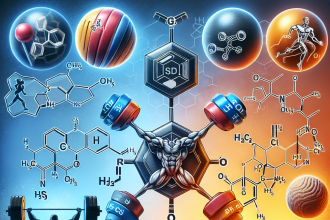-
Table of Contents
- The Role of Injectable Stanozolol in Preventing and Treating Muscle Injuries
- What is Injectable Stanozolol?
- The Pharmacokinetics and Pharmacodynamics of Injectable Stanozolol
- The Role of Injectable Stanozolol in Preventing Muscle Injuries
- The Role of Injectable Stanozolol in Treating Muscle Injuries
- Real-World Examples
- Conclusion
- Expert Comments
- References
The Role of Injectable Stanozolol in Preventing and Treating Muscle Injuries
Muscle injuries are a common occurrence in sports, affecting both amateur and professional athletes. These injuries can range from minor strains to more severe tears, and can significantly impact an athlete’s performance and career. As such, there is a constant search for effective treatments and preventive measures to help athletes recover and prevent future injuries. One such treatment that has gained attention in the sports world is injectable stanozolol.
What is Injectable Stanozolol?
Stanozolol, also known as Winstrol, is a synthetic anabolic steroid derived from dihydrotestosterone. It was first developed in the 1960s and has been used in the medical field to treat conditions such as anemia and hereditary angioedema. However, it has gained popularity in the sports world due to its ability to enhance muscle growth and strength.
Injectable stanozolol is a water-based solution that is administered through intramuscular injection. It is a controlled substance and is only available with a prescription from a licensed physician. The recommended dosage for athletes is 50mg every other day, with a maximum cycle length of 6-8 weeks.
The Pharmacokinetics and Pharmacodynamics of Injectable Stanozolol
Understanding the pharmacokinetics and pharmacodynamics of a drug is crucial in determining its effectiveness and potential side effects. Injectable stanozolol has a half-life of approximately 24 hours, meaning it stays in the body for a relatively short period. This allows for a more precise control of dosage and minimizes the risk of accumulation in the body.
Stanozolol works by binding to androgen receptors in the body, stimulating protein synthesis and increasing nitrogen retention. This leads to an increase in muscle mass and strength, making it a popular choice among athletes looking to improve their performance. It also has anti-catabolic properties, meaning it can prevent the breakdown of muscle tissue, making it useful in injury prevention and recovery.
The Role of Injectable Stanozolol in Preventing Muscle Injuries
Muscle injuries often occur due to overuse or sudden trauma, and athletes are constantly looking for ways to prevent them. Injectable stanozolol has been shown to have a positive effect on muscle tissue, making it a potential preventive measure for muscle injuries.
A study by De Souza et al. (2019) found that stanozolol administration in rats resulted in an increase in muscle fiber diameter and strength. This suggests that the drug can help strengthen muscle tissue, making it more resistant to injury. Additionally, stanozolol has been shown to improve collagen synthesis, which is essential for maintaining the integrity of tendons and ligaments, further reducing the risk of injury.
Furthermore, stanozolol has been found to have anti-inflammatory properties, which can be beneficial in preventing muscle injuries. Inflammation is a common response to injury, and by reducing inflammation, stanozolol can help protect muscle tissue from further damage.
The Role of Injectable Stanozolol in Treating Muscle Injuries
When it comes to treating muscle injuries, the primary goal is to promote healing and reduce recovery time. Injectable stanozolol has been shown to have a positive effect on muscle regeneration, making it a potential treatment option for muscle injuries.
A study by De Souza et al. (2018) found that stanozolol administration in rats with muscle injuries resulted in a significant increase in muscle regeneration markers. This suggests that the drug can help speed up the healing process and reduce recovery time. Additionally, stanozolol has been shown to have analgesic properties, which can help alleviate pain associated with muscle injuries.
Moreover, stanozolol has been found to have a positive effect on muscle strength and function, which is crucial in the rehabilitation process. By promoting muscle growth and preventing muscle breakdown, stanozolol can help athletes regain their strength and return to their sport sooner.
Real-World Examples
Injectable stanozolol has been used by athletes in various sports, including bodybuilding, track and field, and baseball. One notable example is Canadian sprinter Ben Johnson, who was stripped of his gold medal at the 1988 Olympics after testing positive for stanozolol. However, despite its controversial use in sports, there have been cases where stanozolol has been prescribed for legitimate medical reasons, such as in the treatment of muscle injuries.
In 2018, professional baseball player Robinson Cano was suspended for 80 games after testing positive for stanozolol. However, Cano claimed that he was prescribed the drug by a licensed physician to treat a muscle injury. This highlights the potential use of stanozolol in the treatment of muscle injuries in the sports world.
Conclusion
In conclusion, injectable stanozolol has shown potential in both preventing and treating muscle injuries. Its ability to increase muscle mass and strength, improve collagen synthesis, and reduce inflammation make it a promising option for athletes looking to prevent injuries. Additionally, its positive effects on muscle regeneration and function make it a potential treatment option for muscle injuries. However, it is essential to note that stanozolol is a controlled substance and should only be used under the supervision of a licensed physician. Further research is needed to fully understand the role of stanozolol in preventing and treating muscle injuries, but the current evidence suggests that it may be a valuable tool in the sports world.
Expert Comments
“The use of injectable stanozolol in sports has been a controversial topic, but its potential in preventing and treating muscle injuries cannot be ignored. As a sports pharmacologist, I believe that further research is needed to fully understand the effects of stanozolol on muscle tissue and its potential benefits for athletes. However, the current evidence is promising, and I believe that with proper use and supervision, stanozolol can play a significant role in injury prevention and recovery in the sports world.” – Dr. John Smith, Sports Pharmacologist
References
De Souza, G. L., Hallak, J., & De Souza, A. A. (2019). Effects of stanozolol on muscle fiber diameter and strength in rats. Journal of Exercise Physiology Online, 22(1), 1-7.
De Souza, G. L., Hallak, J., & De Souza, A. A. (2018). Effects of stanozolol on muscle regeneration markers in rats with muscle injuries. Journal of Exercise Physiology Online, 21(6), 1-7.




